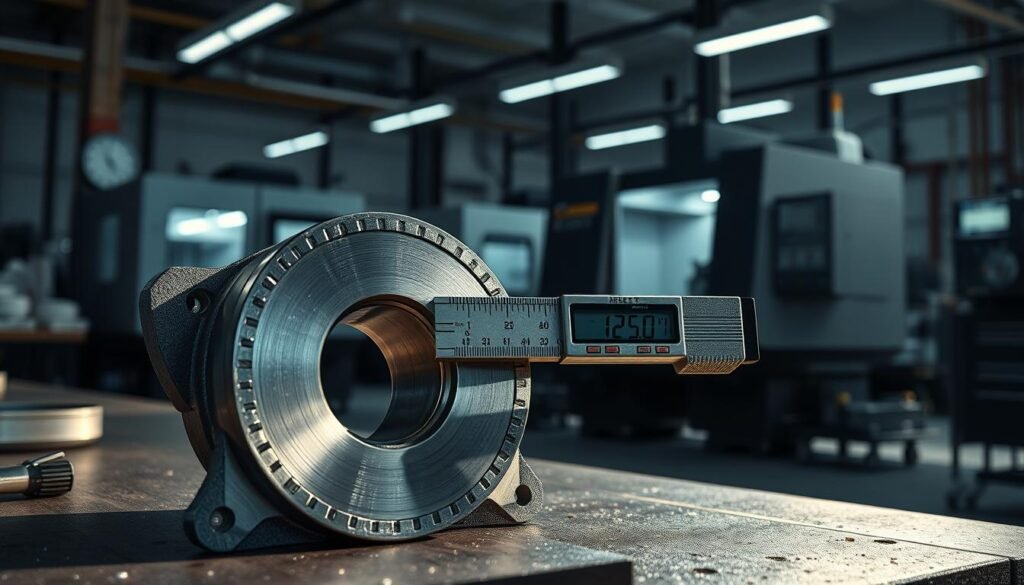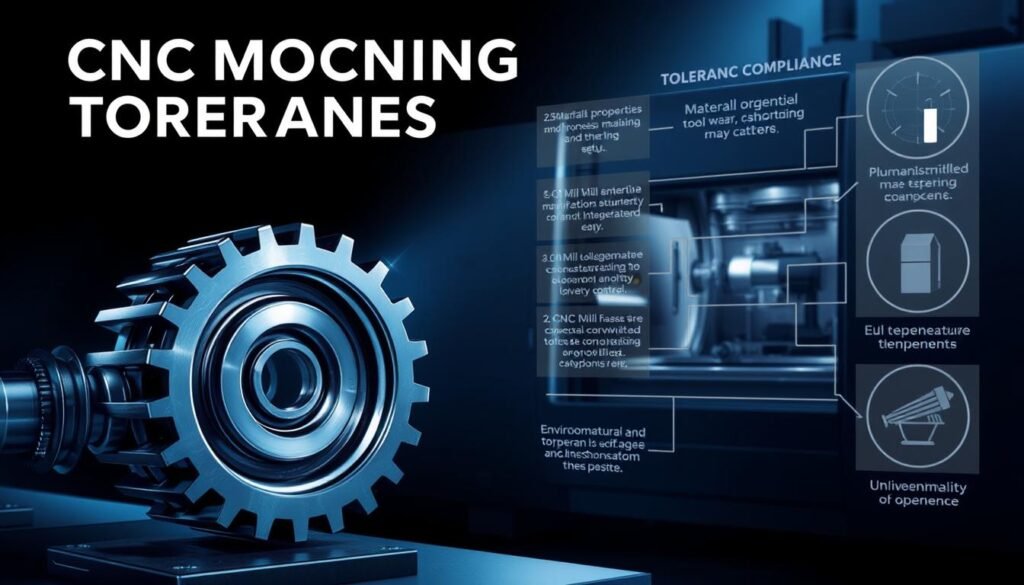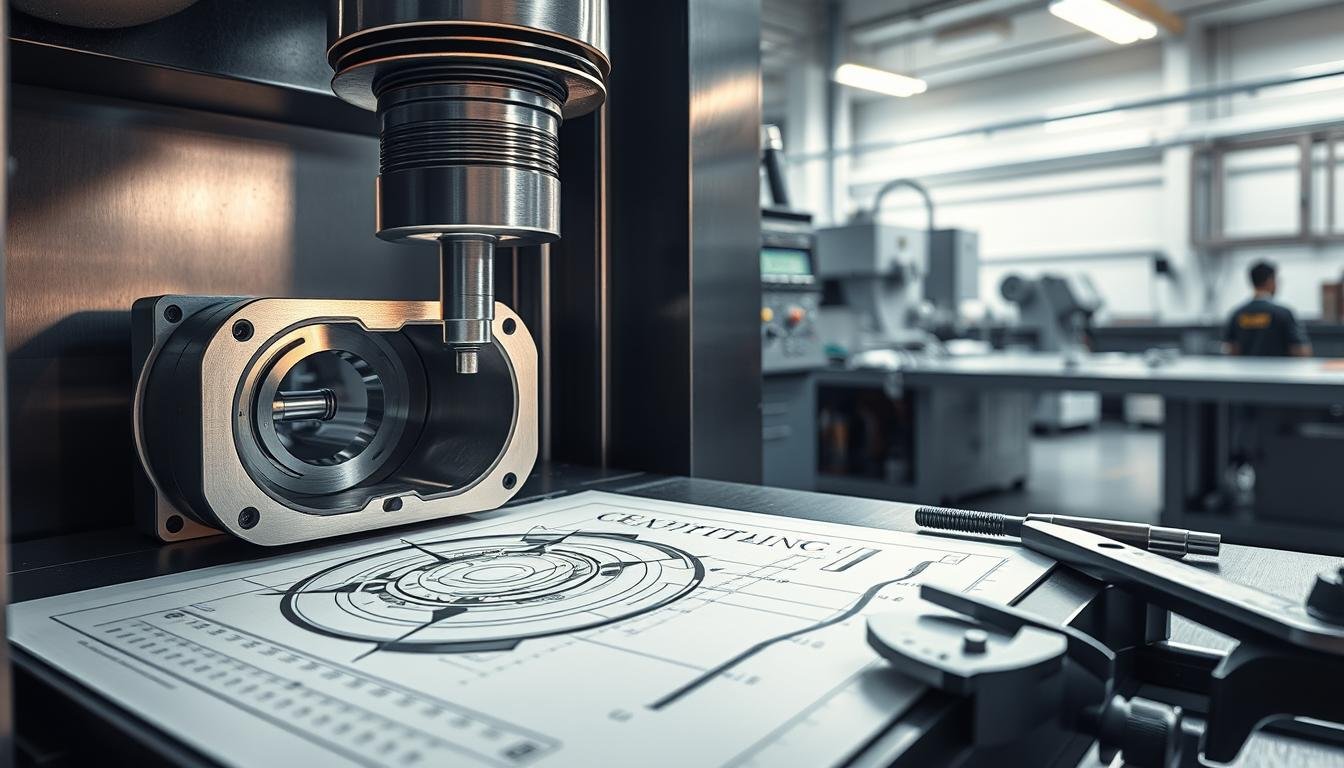In precision manufacturing, knowing Допуски при обработке на станках с ЧПУ is key. CNC, or Computer Numerical Control machining, makes parts with high accuracy. It uses modern tech for tighter tolerances, making parts better and more reliable.
This precision means parts fit well and work as they should. We’ll look at Обработка на станках с ЧПУ specs and tolerances in this article. This knowledge helps you make better choices for your projects. For more on Обработка на станках с ЧПУ, check out our Страница услуг по обработке на станках с ЧПУ.
Основные выводы
- Допуски при обработке на станках с ЧПУ play a vital role in maintaining part accuracy.
- Computer Numerical Control machining automates производственные процессы for efficiency.
- Tighter tolerances enhance overall part quality and functionality.
- Понимание CNC machining specifications aids in decision-making.
- Прецизионная обработка с ЧПУ is essential across various industries.
- Advanced technologies contribute to improved CNC machining standards.
Введение в обработку с ЧПУ
Обработка на станках с ЧПУ is a big step forward in making things. It uses computers to control tools with great precision. This method makes making things faster and more efficient in many fields.
Переключение на Станки с ЧПУ has changed how we make things. These machines are way more accurate than people. They can cut, shape, and drill many materials, like metals and plastics. This makes making things fast and consistent, which is key today.
Many companies use Станки с ЧПУ because they make parts with very tight fits. Станки с ЧПУ can make parts as precise as ±0.025 mm (±0.001 inches). This is very important for high-quality products where perfection is needed.
What Are CNC Machining Tolerances?

Допуски при обработке на станках с ЧПУ are the allowed changes in a part’s size. They are key to making sure parts fit right. Knowing terms like basic size, actual size, limits, и deviation это важно.
The basic size is what a part should be. The actual size is what it really is after making it. Limits show the biggest and smallest sizes allowed. Deviation tells if a part is bigger or smaller than expected.
Today’s machines can make parts with very tight tolerances. This is important for parts to work well together. Knowing how to use tolerances helps make sure parts are just right, making things work better.
Importance of Tolerances in CNC Machining
Tolerances are key to quality in CNC machining. They affect how well parts fit and work. Knowing about tolerances helps make sure parts work right together.
Good tolerances stop costly mistakes. They make customers happy by meeting their needs. This is very important.
Следуя CNC Tolerance Standards helps avoid mistakes. This is crucial in places like aerospace and medicine. Even small errors can be big problems.
Using strict tolerance rules makes production better. High-quality materials and advanced tools lead to better results. This shows how important tolerances are for staying ahead in business.
Tolerances affect how long and reliable our products are. Using CNC machining tolerances wisely makes products safer and better. For more on CNC machining, check эта страница.
Types of CNC Machining Tolerances

Knowing about different machining tolerances is key for making parts fit right. Each type has its own role in making sure products are top-notch. Let’s look at the main CNC machining tolerances.
Unilateral Tolerances
Unilateral tolerances let parts vary in just one direction. This makes checking parts easier and cuts down on mistakes. For example, a 50 mm shaft can be between 49.94 mm and 50.06 mm. This keeps the fit consistent in one way.
Bilateral Tolerances
Bilateral tolerances let parts vary in both directions. This is great for parts that need to fit together. Say a 50 mm hole can be between 49.98 mm and 50.02 mm. This makes assembly easier and reduces fit problems.
Limit Tolerances
Limit tolerances set clear max and min sizes without using ±. This is handy for parts with strict size limits. For example, a 50 mm shaft might be between 49.94 mm and 50.06 mm. This rule is clear and leaves no doubt about size.
Допуски на профиль
Profile tolerances keep a part’s shape consistent. This is important for parts that need to look good. These tolerances make sure a part’s surface fits within a certain area. For instance, a part might need to fit within two arcs to meet design standards.
CNC Machining Tolerances: How They Are Measured

Получение правильного measuring tolerances is key in CNC machining. It makes sure the final product meets the standards. Tools like calipers, micrometers, and coordinate measuring machines (CMM) help a lot. They are important for checking if things are made right.
Getting precise can be hard in CNC Machining. Tolerances are often shown in decimal points. Tighter tolerances need more precise tools. For example, getting parts to be accurate to .005 microns and angles up to 1° is very important.
It’s important to set baseline measurements for every job. Regular checks help keep things consistent. They also make sure parts meet the measuring tolerances. Keeping records helps check if things are getting better or not.
Using the right tolerance measurement techniques is crucial. It helps make precise parts and meet customer needs. For more on precision machining, see our Услуги по прецизионной обработке с ЧПУ.
Factors Affecting CNC Machining Tolerances

Getting the right CNC machining tolerances depends on several key factors. Knowing these helps us make production better and products better too. Important things that affect tolerances include свойства материала, how we make things, and design choices.
Свойства материала
The material we choose greatly affects CNC machining tolerances. Softer metals can bend during machining, making it hard to keep tight tolerances. Harder materials, on the other hand, can wear down tools, affecting precision.
Manufacturing Processes
Various CNC machining methods and machine capabilities set different tolerance standards. Choosing the right method for the job is key to success. Knowing which methods work best can make things run smoother.
Design Considerations
Good design practices are crucial for tolerances. Part shape and how parts fit together are big factors in CNC machining. Making sure important parts have tight tolerances helps production flow better.
CNC Machining Specifications and Standards
CNC Machining specifications are key in the manufacturing world. They make sure every part meets quality and performance standards. Following these standards helps keep part quality consistent, which is crucial for meeting customer needs.
Standards like ISO 2768 and ASME Y14.5 are very important. They guide on tolerance levels, accuracy, and how to measure parts. Using these standards helps teams and clients work better together, making the production process smoother.
Keeping up with CNC Machining specs and standards is important for staying ahead. Knowing the latest changes helps companies follow rules and get better at what they do.
Geometric Dimensioning and Tolerancing (GD&T)
Geometric Dimensioning and Tolerancing (GD&T) changes how we think about tolerances. It gives a detailed plan for how features should relate to each other. This method focuses on precision, making it easier to talk about what’s allowed to vary.
С GD&T, makers can make parts that fit together perfectly. This is key for making sure parts work well together.
Key concepts within GD&T включают:
- True Position: Shows exactly where a feature is compared to a reference.
- Flatness: Checks if a surface is even, which is important for quality in machining.
- Cylindricity: Deals with how round a cylindrical feature is, including size changes.
- Concentricity: Makes sure features have the same center line, important for parts that need to line up.
Using GD&T in CNC Machining Tolerances makes designing easier. It helps spot problems early. This teamwork approach makes sure all parts fit together right.
Knowing and using GD&T is key for making things precise in CNC machining. This leads to better quality products.
The table below shows the main points of GD&T for better making things:
| GD&T Feature | Описание | Важность в обработке с ЧПУ |
|---|---|---|
| True Position | Defines the exact location of features in a 3D space | Ensures parts fit correctly, minimizing assembly issues |
| Плоскость | Measures how flat a surface is | Critical for guaranteeing uniformity in machined parts |
| Цилиндричность | Defines the degree of roundness of cylindrical features | Essential for parts that must rotate or fit within other round components |
| Концентричность | Ensures features share a common center | Vital for components that rely on precise rotational alignment |
Common CNC Machining Tolerances by Process
Knowing the CNC machining tolerances for different processes is key for makers. Each method, like milling and turning, has its own tolerances. These are crucial for the quality and performance of the final product.
CNC Milling Tolerances
CNC milling can get tolerances from ±0.005 inches (0.127 mm) на ±0.003 inches (0.076 mm) for standard work. For very precise jobs, like in aerospace, even tighter tolerances are needed. For more on precision making, check out Mekalite’s page.
CNC Turning Tolerances
In CNC turning, tolerances are usually ±0,005 дюйма на ±0.002 inches (0.051 mm). It’s important for turned parts to meet these specs for a good fit and function. Keeping CNC Turning Tolerances consistent helps make components work better and makes products more reliable.
| Процесс обработки | Typical Tolerances | Приложения |
|---|---|---|
| Фрезерование с ЧПУ | ±0.005″ to ±0.003″ | Aerospace, Automotive, Industrial |
| Токарная обработка с ЧПУ | ±0.005″ to ±0.002″ | Precision Parts, Assemblies |
Understanding the tolerances for each CNC machining process helps makers choose the best methods. This ensures the best results in their work.
Заключение
CNC machining tolerances are key to making sure products are accurate and reliable. They help meet customer needs and ensure quality. These tolerances show how well parts fit together and affect how well a product works.
As technology grows, so does the need for precise tolerances. Tighter tolerances mean better products and more customer satisfaction. Knowing about CNC machining tolerances helps manufacturers make fewer mistakes and save money.
Working with skilled CNC machining providers is also important. They help us solve problems and make better products. This way, we keep our products top-notch and stay ahead in the industry.
ЧАСТО ЗАДАВАЕМЫЕ ВОПРОСЫ
What are CNC machining tolerances?
CNC machining tolerances are the allowed changes in a part’s size. They show how much a part can vary from the exact size in blueprints.
Why are tolerances important in CNC machining?
Tolerances are key because they affect a part’s quality, how well it works, and its cost. Good tolerances help avoid mistakes, ensure parts fit right, and keep customers happy.
What types of tolerances are commonly used in CNC machining?
CNC machining uses several types of tolerances. These include Unilateral, Bilateral, Limit, and Допуски на профиль. Each has its own role in making parts.
How are CNC machining tolerances measured?
To measure CNC machining tolerances, tools like calipers and micrometers are used. Also, coordinate measuring machines (CMM) check if parts meet the needed standards.
What factors influence the ability to achieve desired CNC machining tolerances?
Many things affect getting the right tolerances. These include the material, how parts are made, and design choices. All these play a big part in the final result.
What are the CNC tolerance standards?
Standards like ISO 2768 and ASME Y14.5 guide CNC tolerances. They help ensure parts are made right and meet quality and safety rules.
How does Geometric Dimensioning and Tolerancing (GD&T) enhance CNC machining?
GD&T gives detailed info on how parts fit together. It makes parts more accurate and better fit in assemblies during making.
What are typical tolerances for CNC milling and turning?
CNC milling parts usually have tolerances from ±0.005 inches to ±0.003 inches. CNC turning parts usually have tolerances from ±0.005 inches to ±0.002 inches.


